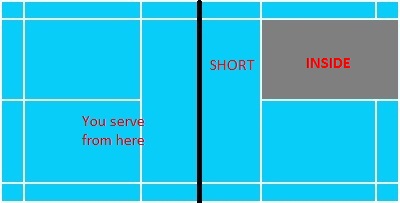Basic Badminton Rules
Why care about the rules?
You won’t feel lost in the middle of your games. Imagine a situation when you’re not aware of the score and your game has actually finish. Let’s say you’re playing singles. Your opponent is waiting to shake your hand at the net where as you’re preparing for your next service. How embarrassing things could turn up!
You can even call a fault on your opponent if he or she tries to break the rules to gain some advantage in the game.
You’ll enjoy badminton even more when you play according to the proper rules.
You might also want to learn some common Badminton Terms or language. I’ll be using some common badminton terms throughout my website, so it’s definitely an advantage for you if we share the same ‘language’.
The intention of this page is to get you started in playing badminton. If you want to host a professional tournament, you should look at the official rules here.
Let’s begin with some simple badminton rules…
1. How to Play Badminton?
In very simple terms…
A rally starts with a serve.
A rally ends when:
- the shuttle touches the ground or get caught by the net.
- someone commits a fault.
You’ll be awarded with ONE point when you win a rally. Win 21 rallies and you’ll win the game.
2. Badminton Court Size and Measurement
Interestingly, I get a couple of questions on how a badminton court look like and what’s its measurements.
So here’s your info on Badminton Court Size.
3. Who serves at ‘Love All’?
In official tournaments, we toss a coin to decide who starts first. In casual games, this doesn’t really matter. Different countries have different interesting ways to decide who serves first.
In Malaysia and Australia, we hit the shuttle high up into the air and let it fall to the ground. If the head of shuttlecock points towards my side on the floor, I’ll serve.
4. In Out Boundaries (Singles and Doubles)
Service boundaries. Serve to the gray area. If your serve land on the court within the gray area, you get a point.
|
Singles |
 |
|
Doubles |
 |
In/Out Boundaries. After the receiver retrieves the serve, the yellow area becomes the In/Out boundaries. If the shuttlecock lands anywhere within the yellow area, you get a point.
|
Singles |
 |
|
Doubles |
 |
What happens when the shuttlecock falls on the line between the Inside and Outside area of the court?
I find this question very popular among beginners. If this happens, the shuttlecock is considered as dropping INSIDE the court.
5. Serving and Receiving – Where to Stand?
Where should I stand while serving and receiving? When serving, stand within the service box; while receiving, stand within the receiver’s box.
For example in singles…
Service Box

Basically, you can stand anywhere within the Yellow area to serve. Ideally, you’ll want to stand at the red dot to serve in singles.
Receiver’s Box

You can stand anywhere within the Yellow area to receive the serve. Most players will choose to stand at the Red dot to receive the serve.
Common Question: Can I stand ON the lines of the Service and Receiver’s box while serving/receiving?
No you can’t. It’s a fault. Any part of your feet should not be on top of those lines.
6. Badminton Scoring System – 21 Points
Badminton Scoring is based on the 21 points system or known as the new rules to most people.
Learn how to count your points and serve from the correct position during a badminton game. Your badminton game will become more interesting and fun if you know how the badminton scoring system works.
7. Badminton Fouls or Fault
Basically there are 5 types of faults in badminton.
- Contact Fault
- Over the Net Fault
- Service Fault
- Receiver Fault
- Doubles Hit
It is important to know what are you not suppose to do during a badminton game in order to avoid losing unnecessary points.
I highly recommend the you know these basic Badminton Fouls.
Badminton rules may sound complicated at the start. But as you play more badminton, you’ll get to know them like they’re at the back of your head!
I hope you found what you’re looking for on this page. Otherwise, let me know in the comments below.
8. Badminton Rules for Doubles
The rules for singles and doubles are the same! However the rules might get a little messy with doubles since there are 2 players on the court.
This page on Badminton Rules for Doubles summarizes all the rules you need to know in order to play a casual game of doubles.

Tell me what you think!
What do you think about what you just read? Leave me a comment below.